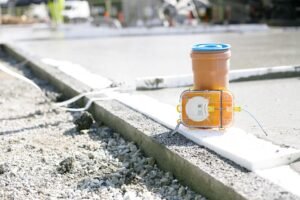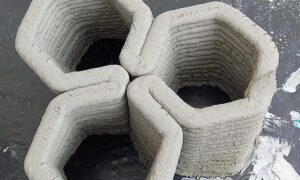Concrete has been a cornerstone of construction for centuries, shaping skylines, infrastructure, and communities around the globe. As we look to the future,innovative concrete technologies are not only enhancing the performance of this essential material but also addressing key challenges like sustainability,durability,and cost-efficiency. Let’s explore three groundbreaking concrete technologies that are revolutionizing the construction landscape and paving the way for a more resilient and eco-pleasant built habitat.
One of the most exciting advancements in concrete technology is self-healing concrete. Imagine a world where the concrete in buildings and infrastructure can repair its own minor damages, much like a living being. This remarkable material has the unique ability to automatically fix its own cracks, offering a new standard of durability in construction. The secret behind this innovative technology lies in the incorporation of bacteria into the concrete mix.
These specialized bacteria, typically from the Bacillus genus, are capable of surviving in the harsh alkaline environment of concrete. They remain dormant until cracks form and water seeps into the structure, at which point they become active. Once awakened, these microscopic healers begin to metabolize available nutrients, leading to the production of calcium carbonate. This white, powdery substance effectively fills in the cracks, sealing them and restoring the integrity of the concrete.
The process is remarkably similar to how our skin regenerates after injuries and scrapes. When a crack appears, the bacteria spring into action, producing limestone to fill the gap. This natural healing process can take anywhere from 15 days to a month, depending on the size of the crack. Tests have shown that cracks about one to two millimeters wide and 12 centimeters long can be healed in around 30 days.
The implications of self-healing concrete are vast. By autonomously repairing cracks, this technology extends the lifespan of structures, requiring less maintenance over time. This not only translates to economic savings but also represents a revolution in our traditional understanding of infrastructure maintenance. From an environmental perspective, the advantages are equally impressive. By reducing the need for frequent, energy-consuming repairs, self-healing concrete lessens the carbon footprint associated with construction and maintenance activities.
Moving from microscopic healers to cutting-edge manufacturing techniques, our second innovative concrete technology is 3D-printed concrete. This revolutionary approach is transforming the way we design and construct buildings, offering unprecedented adaptability and efficiency in the construction process.
3D printing in construction involves extruding layers of concrete to build structures directly on-site or in a controlled factory setting.This technology allows architects and builders to create complex designs that were previously impossible or prohibitively expensive to realize. The precision of 3D printing also minimizes waste by using exact amounts of material, aligning perfectly with the growing emphasis on sustainable construction practices.
One of the most exciting aspects of 3D-printed concrete is its potential to dramatically speed up construction timelines. Traditional construction methods often involve multiple steps and various trades working in sequence. With 3D printing, entire sections of a building can be produced in a single, continuous process. This not only saves time but also reduces the potential for errors and inconsistencies that can occur with traditional methods.
Moreover, 3D-printed concrete opens up new possibilities for customization and design innovation. Architects can now create intricate geometries and unique structural elements that would be incredibly challenging to achieve with conventional formwork and pouring techniques. This freedom of design allows for the creation of more efficient and aesthetically pleasing structures, pushing the boundaries of what’s possible in architectural expression.
The third innovative concrete technology shaping the future of construction is carbon-capture concrete. This groundbreaking material addresses one of the most pressing challenges facing the construction industry: the notable carbon footprint associated with cement production. Cement, the key binding ingredient in concrete, is responsible for about 7% of global CO2 emissions. Carbon-capture concrete aims to turn this environmental liability into an asset.
The technology behind carbon-capture concrete involves incorporating captured CO2 directly into the concrete mix, where it becomes permanently stored as a mineral. This process not only reduces the carbon footprint of construction projects but can also enhance the material’s strength and durability. It’s a prime example of how innovative thinking can transform a problem into a solution, aligning the construction industry with global goals to reduce greenhouse gas emissions and create more sustainable cities.
The concept builds on the natural process of carbonation, where concrete gradually absorbs CO2 from the atmosphere over its lifetime. Carbon-capture technology accelerates this process, actively sequestering carbon dioxide during the manufacturing stage. Some approaches use CO2 as a curing agent, replacing the energy-intensive steam curing process typically used in precast concrete production. Others inject CO2 into the concrete mix, where it reacts with calcium ions to form solid calcium carbonate, effectively locking the carbon dioxide into the material’s structure.
The benefits of carbon-capture concrete extend beyond environmental considerations. The mineralization process can improve the concrete’s compressive strength, potentially allowing for the use of less material while maintaining structural integrity. This could lead to more efficient designs and further reductions in the overall carbon footprint of construction projects.
As we look to the future, these three innovative concrete technologies – self-healing concrete, 3D-printed concrete, and carbon-capture concrete – represent just the tip of the iceberg in terms of advancements in construction materials. They exemplify the industry’s commitment to addressing key challenges such as durability, efficiency, and sustainability.
The integration of these technologies into mainstream construction practices holds the promise of creating buildings and infrastructure that are not only stronger and more resilient but also more environmentally friendly. As research continues and these innovations are refined and scaled up, we can expect to see a transformation in the way we build our cities and communities.
The future of construction is being shaped by these remarkable advancements in concrete technology. From concrete that can heal itself to structures printed layer by layer, and materials that actively combat climate change, these innovations are setting new standards for what’s possible in the built environment. As we continue to push the boundaries of material science and construction techniques, we’re not just building structures – we’re laying the foundation for a more sustainable and resilient future.











